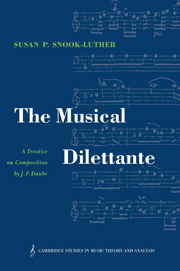Book contents
- Frontmatter
- Contents
- Foreword
- Translator's preface
- Introduction
- THE MUSICAL DILETTANTE: A TREATISE ON COMPOSITION (1773)
- Preface
- 1 Harmony in general
- 2 The three different motions of the voices
- 3 Combining two voices
- 4 Combining three voices
- 5 Combining four voices
- 6 Composition in five and more parts
- 7 Variation
- 8 Imitation
- 9 Canon
- 10 Simple fugue
- 11 Double counterpoint
- 12 Double fugue
- Bibliography
- Index
10 - Simple fugue
Published online by Cambridge University Press: 15 October 2009
- Frontmatter
- Contents
- Foreword
- Translator's preface
- Introduction
- THE MUSICAL DILETTANTE: A TREATISE ON COMPOSITION (1773)
- Preface
- 1 Harmony in general
- 2 The three different motions of the voices
- 3 Combining two voices
- 4 Combining three voices
- 5 Combining four voices
- 6 Composition in five and more parts
- 7 Variation
- 8 Imitation
- 9 Canon
- 10 Simple fugue
- 11 Double counterpoint
- 12 Double fugue
- Bibliography
- Index
Summary
The discussion of imitation provides the basis for the construction of fugues. Just as we have said in the foregoing pages, that variation is the basis of melody, which arises from it, so we can say here that when a melodic motif is invented, the art of imitation teaches how it might be repeated. A piece in which such a repetition [i.e., answer] is instituted, continued, and carried out to the conclusion according to certain rules is called a fugue.
The main characteristic of a fugue should be that the initial theme is melodic and animated, and that the secondary motives fit together well with the main motif or initial theme, so that it would seem as if it were a single voice proceeding from beginning to end. Even if the upper voice does rest now and then, the melodic line still must be arranged so that there might be a continuity between the main theme in the low register and the upper voice which just ceased, and likewise when it joins in again. In the treatise on musical style we intend to tell how this might be achieved.
If a fugue has these characteristics, it can be called excellent, and accordingly can be used everywhere. What are all our good current pieces – symphonies, opera arias, concertos, etc. – other than unbound or approximate fugues? This means, above all, the imitation of one or two main motives.
- Type
- Chapter
- Information
- The Musical DilettanteA Treatise on Composition by J. F. Daube, pp. 186 - 213Publisher: Cambridge University PressPrint publication year: 1992



